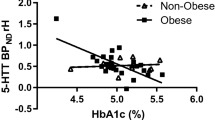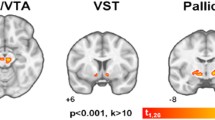Abstract
Purpose
The role of the central serotonin (5-hydroxytryptamine, 5-HT) system in feeding has been extensively studied in animals with the 5-HT family of transporters (5-HTT) being identified as key molecules in the regulation of satiety and body weight. Aberrant 5-HT transmission has been implicated in the pathogenesis of human obesity by in vivo positron emission tomography (PET) and single-photon emission computed tomography (SPECT) imaging techniques. However, results obtained thus far from studies of central 5-HTT availability have been inconsistent, which is thought to be brought about mainly by the low number of individuals with a high body mass index (BMI) previously used. The aim of this study was therefore to assess 5-HTT availability in the brains of highly obese otherwise healthy individuals compared with non-obese healthy controls.
Methods
We performed PET using the 5-HTT selective radiotracer [11C] DASB on 30 highly obese (BMI range between 35 and 55 kg/m2) and 15 age- and sex-matched non-obese volunteers (BMI range between 19 and 27 kg/m2) in a cross-sectional study design. The 5-HTT binding potential (BPND) was used as the outcome parameter.
Results
On a group level, there was no significant difference in 5-HTT BPND in various cortical and subcortical regions in individuals with the highest BMI compared with non-obese controls, while statistical models showed minor effects of age, sex, and the degree of depression on 5-HTT BPND.
Conclusion
The overall finding of a lack of significantly altered 5-HTT availability together with its high variance in obese individuals justifies the investigation of individual behavioral responses to external and internal cues which may further define distinct phenotypes and subgroups in human obesity.




Similar content being viewed by others
References
Leibowitz SF. Hypothalamic neurotransmitters in relation to normal and disturbed eating patterns. Ann N Y Acad Sci. 1987;499:137–43.
Garfield AS, Heisler LK. Pharmacological targeting of the serotonergic system for the treatment of obesity. J Physiol. 2009;587:49–60.
Smith SR, Weissman NJ, Anderson CM, Sanchez M, Chuang E, Stubbe S, et al. Behavioral Modification and Lorcaserin for Overweight and Obesity Management (BLOOM) Study Group. Multicenter, placebo-controlled trial of lorcaserin for weight management. N Engl J Med. 2010;363:245–56.
Huang XF, Huang X, Han M, Chen F, Storlien L, Lawrence AJ. 5-HT2A/2C receptor and 5-HT transporter densities in mice prone or resistant to chronic high-fat diet-induced obesity: a quantitative autoradiography study. Brain Res. 2004;1018:227–35.
Ratner C, Ettrup A, Bueter M, Haahr ME, Compan V, le Roux CW, et al. Cerebral markers of the serotonergic system in rat models of obesity and after Roux-en-Y gastric bypass. Obesity (Silver Spring). 2012;20:2133–41.
Haahr ME, Rasmussen PM, Madsen K, Marner L, Ratner C, Gillings N, et al. Obesity is associated with high serotonin 4 receptor availability in the brain reward circuitry. Neuroimage. 2012;61:884–8.
Erritzoe D, Frokjaer VG, Haugbol S, Marner L, Svarer C, Holst K, et al. Brain serotonin 2A receptor binding: relations to body mass index, tobacco and alcohol use. Neuroimage. 2009;46:23–30.
Erritzoe D, Frokjaer VG, Haahr MT, Kalbitzer J, Svarer C, Holst KK, et al. Cerebral serotonin transporter binding is inversely related to body mass index. Neuroimage. 2010;52:284–9.
Hesse S, Villringer A, Schönknecht P, Becker GA, Patt M, Bresch A, et al. Serotonin transporter (SERT) availability, body mass index (BMI) and depression. J Nucl Med. 2009;50 Suppl 2:1294.
Haahr ME, Hansen DL, Fisher PM, Svarer C, Stenbæk DS, Madsen K, et al. Central 5-HT Neurotransmission modulates weight loss following gastric bypass surgery in obese individuals. J Neurosci. 2015;35:5884–9.
Hautzinger M. Das Beck Depressions-Inventar (BDI) in der Klinik. Nervenarzt. 1991;62:689–6.
Hesse S, Stengler K, Regenthal R, Patt M, Becker GA, Franke A, et al. The serotonin transporter availability in untreated early-onset and late-onset patients with obsessive-compulsive disorder. Int J Neuropsychopharmacol. 2011;14:606–17.
Wilson AA, Ginovart N, Schmidt M, Meyer JH, Threlkeld PG, Houle S. Novel radiotracers for imaging the serotonin transporter by positron emission tomography: synthesis, radiosynthesis, and in vitro and ex vivo evaluation of 11C-labeled 2-(phenylthio)araalkylamines. J Med Chem. 2000;43:3103–10.
Ichise M, Liow JS, Lu JQ, Takano A, Model K, Toyama H, et al. Linearized reference tissue parametric imaging methods: application to [11C]DASB positron emission tomography studies of the serotonin transporter in human brain. J Cereb Blood Flow Metab. 2003;23:1096–112.
Innis RB, Cunningham VJ, Delforge J, Fujita M, Gjedde A, Gunn RN, et al. Consensus nomenclature for in vivo imaging of reversibly binding radioligands. J Cereb Blood Flow Metab. 2007;27:1533–9.
Mai JK, Assheuer J, Paxinos G. Atlas of the human brain. 2nd ed. San Diego: Elsevier Academic; 2004.
Hainer V, Kabrnova K, Aldhoon B, Kunesova M, Wagenknecht M. Serotonin and norepinephrine reuptake inhibition and eating behavior. Ann N Y Acad Sci. 2006;1083:252–69.
Stark JA, Davies KE, Williams SR, Luckman SM. Functional magnetic resonance imaging and c-Fos mapping in rats following an anorectic dose of m-chlorophenylpiperazine. Neuroimage. 2006;31:1228–37.
Hesse S, van de Giessen E, Zientek F, Petroff D, Winter K, Dickson JC, et al. Association of central serotonin transporter availability and body mass index in healthy Europeans. Eur Neuropsychopharmacol. 2014;24(8):1240–7.
Koopman KE, Booij J, Fliers E, Serlie MJ, la Fleur SE. Diet-induced changes in the Lean Brain: Hypercaloric high-fat-high-sugar snacking decreases serotonin transporters in the human hypothalamic region. Mol Metab. 2013;2:417–22.
Li CS, Potenza MN, Lee DE, Planeta B, Gallezot JD, Labaree D, et al. Decreased norepinephrine transporter availability in obesity: positron emission tomography imaging with (S, S)-[11C]O-methylreboxetine. Neuroimage. 2014;86:306–10.
Uçeyler N, Schütt M, Palm F, Vogel C, Meier M, Schmitt A, et al. Lack of the serotonin transporter in mice reduces locomotor activity and leads to gender-dependent late onset obesity. Int J Obes (Lond). 2010;34:701–11.
Homberg JR, la Fleur SE, Cuppen E. Serotonin transporter deficiency increases abdominal fat in female, but not male rats. Obesity (Silver Spring). 2010;18:137–45.
Gryglewski G, Lanzenberger R, Kranz GS, Cumming P. Meta-analysis of molecular imaging of serotonin transporters in major depression. J Cereb Blood Flow Metab. 2014;34:1096–103.
Udo T, McKee SA, Grilo CM. Factor structure and clinical utility of the Beck depression inventory in patients with binge eating disorder and obesity. Gen Hosp Psychiatry. 2015;37:120–25.
Zou N, Chetelat G, Baydogan MG, Li J, Fischer FU, Titov D, et al. Metabolic connectivity as index of verbal working memory. J Cereb Blood Flow Metab. 2015;35:1122–6.
Scharmüller W, Übel S, Ebner F, Schienle A. Appetite regulation during food cue exposure: a comparison of normal-weight and obese women. Neurosci Lett. 2012;518:106–10.
Drevets WC, Price JL, Furey ML. Brain structural and functional abnormalities in mood disorders: implications for neurocircuitry models of depression. Brain Struct Funct. 2008;213:93–118.
Northoff G, Wiebking C, Feinberg T, Panksepp J. The ‘resting-state hypothesis’ of major depressive disorder-a translational subcortical-cortical framework for a system disorder. Neurosci Biobehav Rev. 2011;35:1929–45.
Bearer EL, Zhang X, Janvelyan D, Boulat B, Jacobs RE. Reward circuitry is perturbed in the absence of the serotonin transporter. Neuroimage. 2009;46:1091–104.
Acknowledgments
We are very grateful to Damian McLeod, School of Biomedical Sciences and Pharmacy, University of Newcastle, Australia, for careful line editing and English proofreading of the first draft of the manuscript.
Author information
Authors and Affiliations
Corresponding author
Ethics declarations
Funding
This study was supported by the German Federal Ministry of Education and Research (FKZ: 01EO1001).
Conflict of interest
The authors report no conflicts of interest relating to the content of this manuscript.
Ethical approval
All procedures performed in studies involving human participants were in accordance with the ICH Guideline for Good Clinical Practice (GCP) and with the 1964 Helsinki declaration and its later amendments. The study was approved by the ethics committee of the Medical Faculty of the University of Leipzig (registered under the number 206-10-08032010) and the German Bundesamt für Strahlenschutz/Federal Office for Radiation Protection (number Z5-22461-2-2011-002), and registered at the European clinical trial database EudraCT 2012-000568-32) and the German Clinical Trials Register (DRKS).
Informed consent
Informed consent was obtained from all individual participants included in the study.
Rights and permissions
About this article
Cite this article
Hesse, S., Rullmann, M., Luthardt, J. et al. Central serotonin transporter availability in highly obese individuals compared with non-obese controls: A [11C] DASB positron emission tomography study. Eur J Nucl Med Mol Imaging 43, 1096–1104 (2016). https://doi.org/10.1007/s00259-015-3243-y
Received:
Accepted:
Published:
Issue Date:
DOI: https://doi.org/10.1007/s00259-015-3243-y




